Abstract
DIF-1 is a novel chlorinated alkyl phenone which induces differentiation of prestalk cells in Dictyostelium discoideum. It is broken down and inactivated by a cytoplasmic enzyme, DIF-1 3(5)-dechlorinase (hereafter referred to as DIF-1 dechlorinase), which is found only in prestalk cells. We show that DIF-1 dechlorinase levels are induced at least 50-fold when cells are treated with DIF-1. This response is rapid--enzyme activity doubles within 15 min and is fully induced within an hour--and occurs early in development, before other prestalk markers can be induced by DIF-1. Maximum inducibility is seen towards the end of aggregation, when DIF-1 dechlorinase is barely detectable in uninduced cells. The dose-dependence reveals a threshold concentration of DIF-1 (15 nM) below which almost no response is seen. Cyclic AMP, which is the chemoattractant during aggregation and plays a key role in later development, suppresses the induction of DIF-1 dechlorinase by DIF-1. We conclude that induction of DIF-1 dechlorinase is one of the first steps on the developmental pathway which leads to prestalk cell differentiation, and suggest that the resulting negative feedback on DIF-1 levels is an important part of the mechanism by which cells decide whether to become prestalk or prespore cells.
Full text
PDF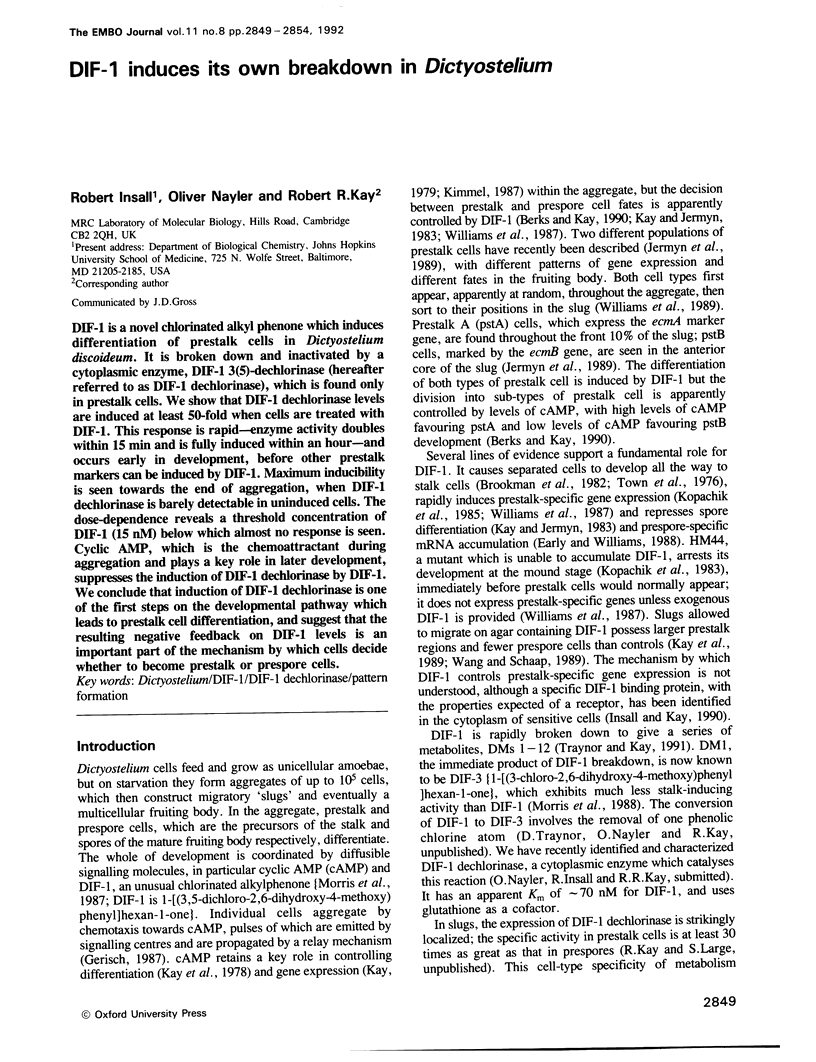
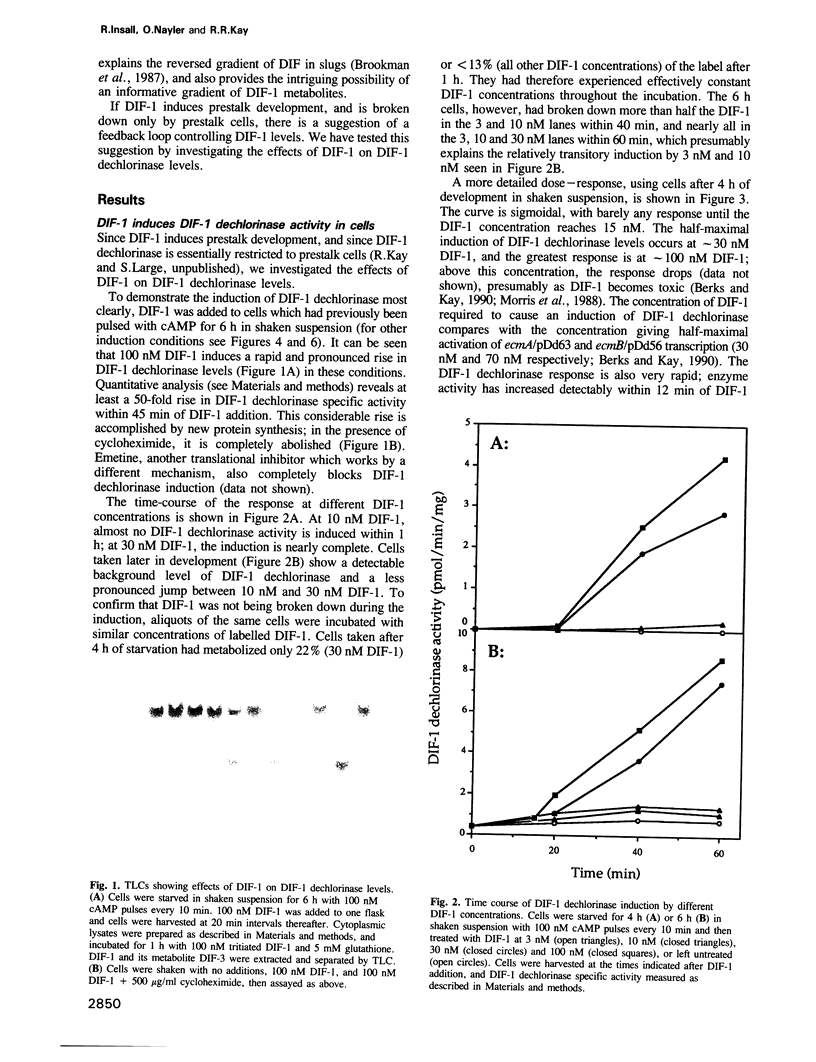
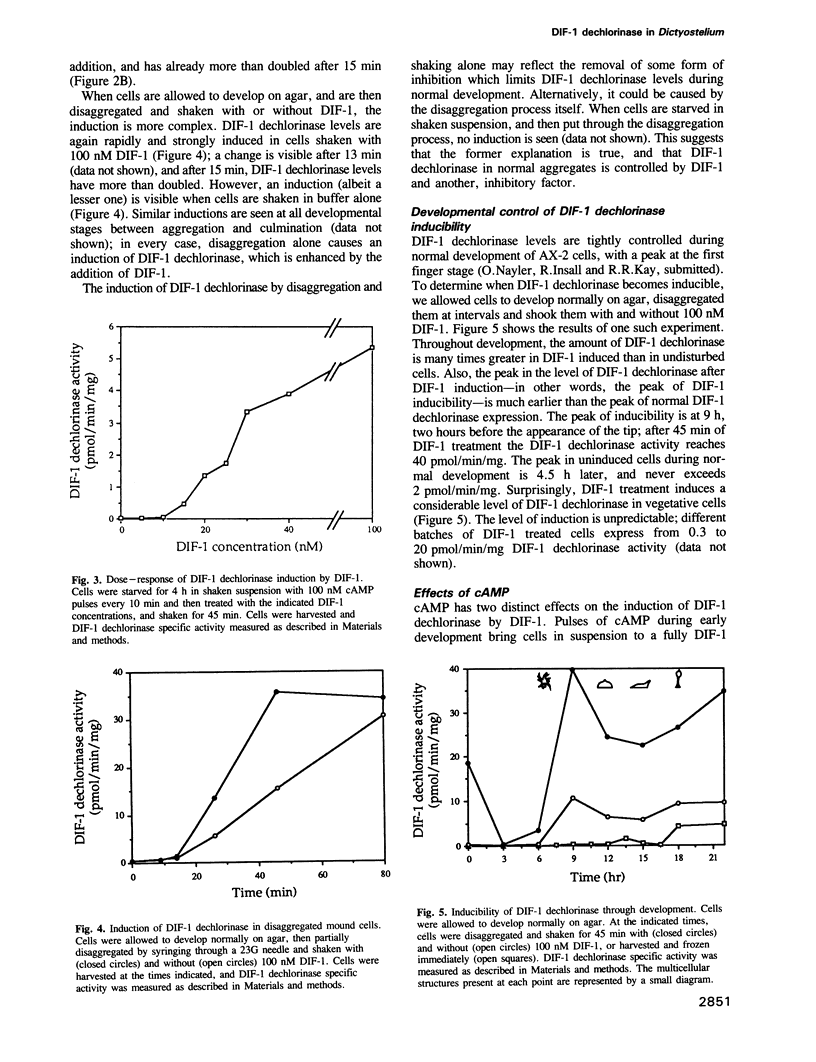
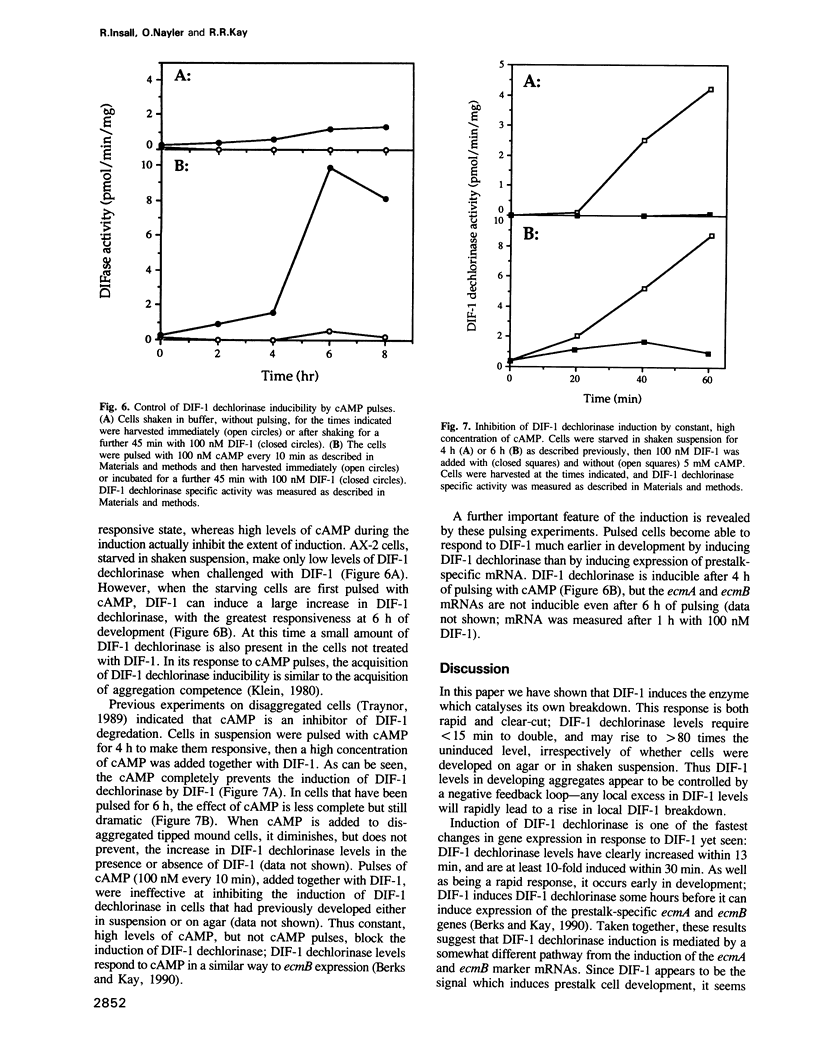
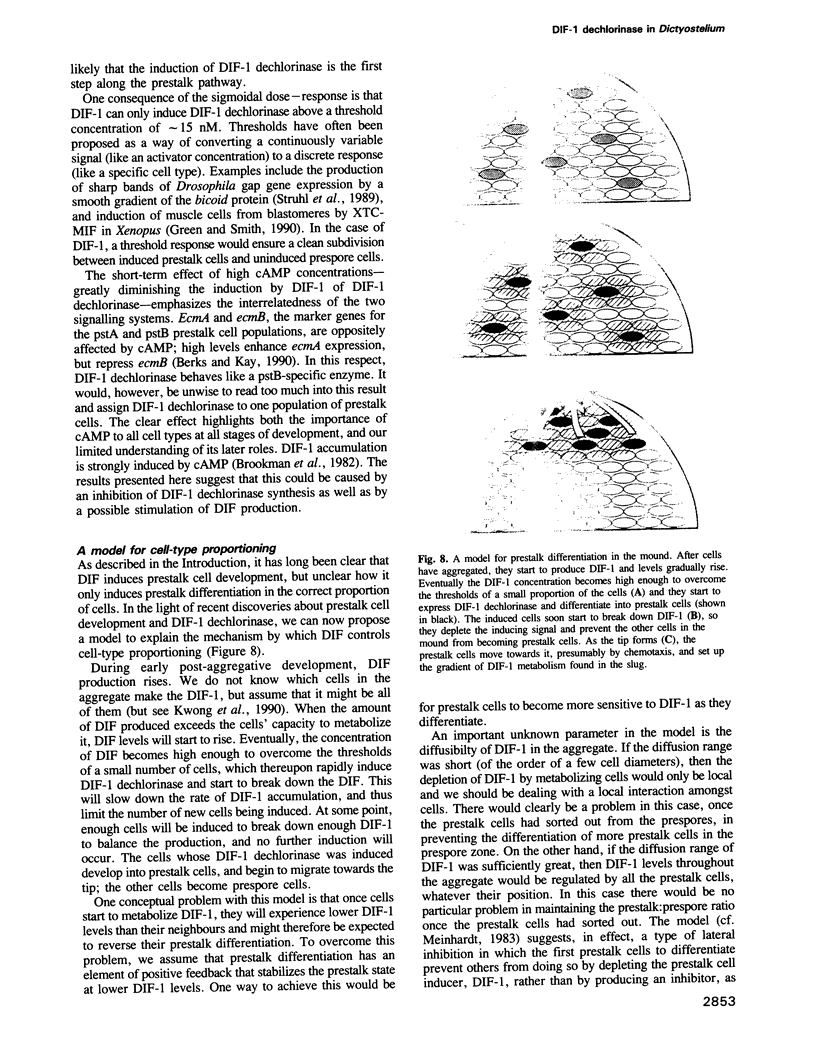
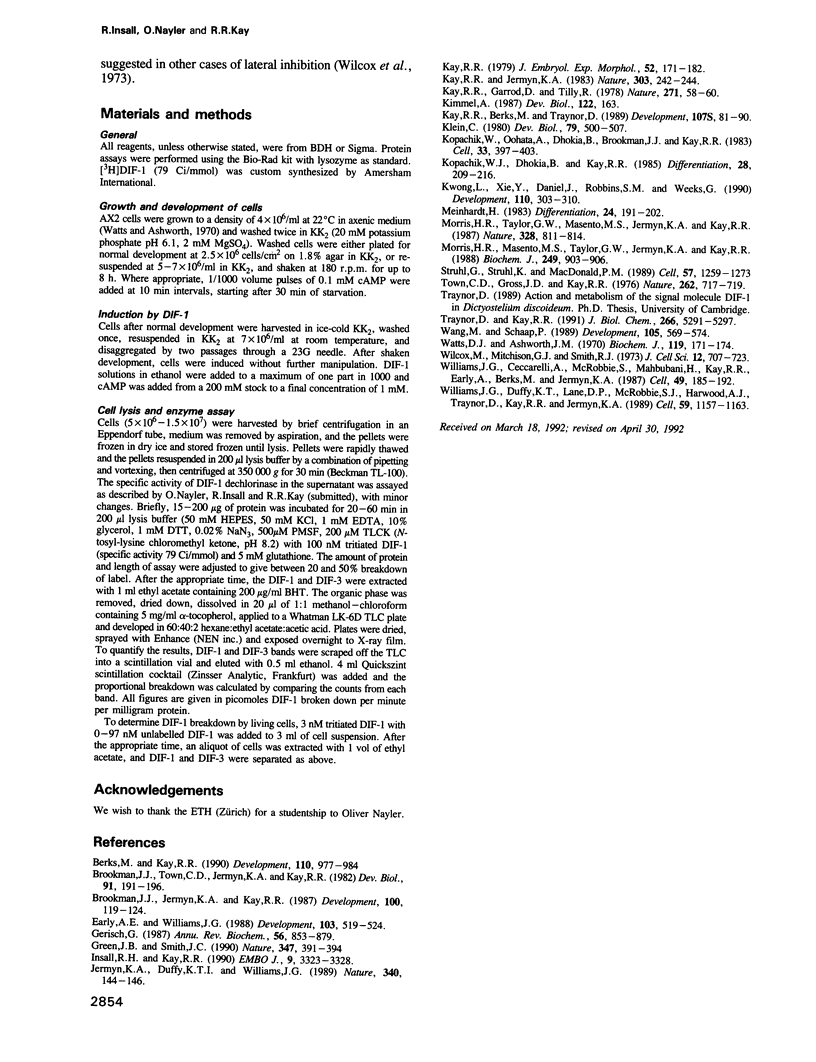
Images in this article
Selected References
These references are in PubMed. This may not be the complete list of references from this article.
- Berks M., Kay R. R. Combinatorial control of cell differentiation by cAMP and DIF-1 during development of Dictyostelium discoideum. Development. 1990 Nov;110(3):977–984. doi: 10.1242/dev.110.3.977. [DOI] [PubMed] [Google Scholar]
- Brookman J. J., Jermyn K. A., Kay R. R. Nature and distribution of the morphogen DIF in the Dictyostelium slug. Development. 1987 May;100(1):119–124. doi: 10.1242/dev.100.1.119. [DOI] [PubMed] [Google Scholar]
- Brookman J. J., Town C. D., Jermyn K. A., Kay R. R. Developmental regulation of a stalk cell differentiation-inducing factor in Dictyostelium discoideum. Dev Biol. 1982 May;91(1):191–196. doi: 10.1016/0012-1606(82)90022-7. [DOI] [PubMed] [Google Scholar]
- Early A. E., Williams J. G. A Dictyostelium prespore-specific gene is transcriptionally repressed by DIF in vitro. Development. 1988 Jul;103(3):519–524. doi: 10.1242/dev.103.3.519. [DOI] [PubMed] [Google Scholar]
- Gerisch G. Cyclic AMP and other signals controlling cell development and differentiation in Dictyostelium. Annu Rev Biochem. 1987;56:853–879. doi: 10.1146/annurev.bi.56.070187.004225. [DOI] [PubMed] [Google Scholar]
- Green J. B., Smith J. C. Graded changes in dose of a Xenopus activin A homologue elicit stepwise transitions in embryonic cell fate. Nature. 1990 Sep 27;347(6291):391–394. doi: 10.1038/347391a0. [DOI] [PubMed] [Google Scholar]
- Insall R., Kay R. R. A specific DIF binding protein in Dictyostelium. EMBO J. 1990 Oct;9(10):3323–3328. doi: 10.1002/j.1460-2075.1990.tb07532.x. [DOI] [PMC free article] [PubMed] [Google Scholar]
- Jermyn K. A., Duffy K. T., Williams J. G. A new anatomy of the prestalk zone in Dictyostelium. Nature. 1989 Jul 13;340(6229):144–146. doi: 10.1038/340144a0. [DOI] [PubMed] [Google Scholar]
- Kay R. R., Berks M., Traynor D. Morphogen hunting in Dictyostelium. Development. 1989;107 (Suppl):81–90. doi: 10.1242/dev.107.Supplement.81. [DOI] [PubMed] [Google Scholar]
- Kay R. R., Garrod D., Tilly R. Requirement for cell differentiation in Dictyostelium discoideum. Nature. 1978 Jan 5;271(5640):58–60. doi: 10.1038/271058a0. [DOI] [PubMed] [Google Scholar]
- Kay R. R. Gene expression in Dictyostelium discoidium: mutually antagonistic roles of cyclic-AMP and ammonia. J Embryol Exp Morphol. 1979 Aug;52:171–182. [PubMed] [Google Scholar]
- Kay R. R., Jermyn K. A. A possible morphogen controlling differentiation in Dictyostelium. Nature. 1983 May 19;303(5914):242–244. doi: 10.1038/303242a0. [DOI] [PubMed] [Google Scholar]
- Kimmel A. R. Different molecular mechanisms for cAMP regulation of gene expression during Dictyostelium development. Dev Biol. 1987 Jul;122(1):163–171. doi: 10.1016/0012-1606(87)90342-3. [DOI] [PubMed] [Google Scholar]
- Klein C. cAMP-independent oscillations of adenylate cyclase in Dictyostelium discoideum. Dev Biol. 1980 Oct;79(2):500–507. doi: 10.1016/0012-1606(80)90135-9. [DOI] [PubMed] [Google Scholar]
- Kopachik W. J., Dhokia B., Kay R. R. Selective induction of stalk-cell-specific proteins in Dictyostelium. Differentiation. 1985;28(3):209–216. doi: 10.1111/j.1432-0436.1985.tb00827.x. [DOI] [PubMed] [Google Scholar]
- Kopachik W., Oohata A., Dhokia B., Brookman J. J., Kay R. R. Dictyostelium mutants lacking DIF, a putative morphogen. Cell. 1983 Jun;33(2):397–403. doi: 10.1016/0092-8674(83)90421-x. [DOI] [PubMed] [Google Scholar]
- Kwong L., Xie Y. J., Daniel J., Robbins S. M., Weeks G. A Dictyostelium morphogen that is essential for stalk cell formation is generated by a subpopulation of prestalk cells. Development. 1990 Sep;110(1):303–310. doi: 10.1242/dev.110.1.303. [DOI] [PubMed] [Google Scholar]
- Meinhardt H. A model for the prestalk/prespore patterning in the slug of the slime mold Dictyostelium discoideum. Differentiation. 1983;24(3):191–202. doi: 10.1111/j.1432-0436.1983.tb01319.x. [DOI] [PubMed] [Google Scholar]
- Morris H. R., Masento M. S., Taylor G. W., Jermyn K. A., Kay R. R. Structure elucidation of two differentiation inducing factors (DIF-2 and DIF-3) from the cellular slime mould Dictyostelium discoideum. Biochem J. 1988 Feb 1;249(3):903–906. doi: 10.1042/bj2490903. [DOI] [PMC free article] [PubMed] [Google Scholar]
- Morris H. R., Taylor G. W., Masento M. S., Jermyn K. A., Kay R. R. Chemical structure of the morphogen differentiation inducing factor from Dictyostelium discoideum. 1987 Aug 27-Sep 2Nature. 328(6133):811–814. doi: 10.1038/328811a0. [DOI] [PubMed] [Google Scholar]
- Struhl G., Struhl K., Macdonald P. M. The gradient morphogen bicoid is a concentration-dependent transcriptional activator. Cell. 1989 Jun 30;57(7):1259–1273. doi: 10.1016/0092-8674(89)90062-7. [DOI] [PubMed] [Google Scholar]
- Town C. D., Gross J. D., Kay R. R. Cell differentiation without morphogenesis in Dictyostelium discoideum. Nature. 1976 Aug 19;262(5570):717–719. doi: 10.1038/262717a0. [DOI] [PubMed] [Google Scholar]
- Traynor D., Kay R. R. The DIF-1 signaling system in Dictyostelium. Metabolism of the signal. J Biol Chem. 1991 Mar 15;266(8):5291–5297. [PubMed] [Google Scholar]
- Watts D. J., Ashworth J. M. Growth of myxameobae of the cellular slime mould Dictyostelium discoideum in axenic culture. Biochem J. 1970 Sep;119(2):171–174. doi: 10.1042/bj1190171. [DOI] [PMC free article] [PubMed] [Google Scholar]
- Wilcox M., Mitchison G. J., Smith R. J. Pattern formation in the blue-green alga, Anabaena. I. Basic mechanisms. J Cell Sci. 1973 May;12(3):707–723. doi: 10.1242/jcs.12.3.707. [DOI] [PubMed] [Google Scholar]
- Williams J. G., Ceccarelli A., McRobbie S., Mahbubani H., Kay R. R., Early A., Berks M., Jermyn K. A. Direct induction of Dictyostelium prestalk gene expression by DIF provides evidence that DIF is a morphogen. Cell. 1987 Apr 24;49(2):185–192. doi: 10.1016/0092-8674(87)90559-9. [DOI] [PubMed] [Google Scholar]
- Williams J. G., Duffy K. T., Lane D. P., McRobbie S. J., Harwood A. J., Traynor D., Kay R. R., Jermyn K. A. Origins of the prestalk-prespore pattern in Dictyostelium development. Cell. 1989 Dec 22;59(6):1157–1163. doi: 10.1016/0092-8674(89)90771-x. [DOI] [PubMed] [Google Scholar]




